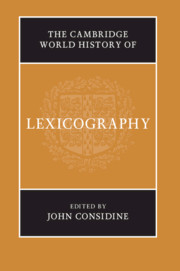Book contents
- The Cambridge World History of Lexicography
- The Cambridge World History of Lexicography
- Copyright page
- Contents
- Contributors
- Editor’s Acknowledgements
- Introduction
- Part I The Ancient World
- Part II The Pre-Modern World
- Part III The Modern World: Continuing Traditions
- Part IV The Modern World: Missionary and Subsequent Traditions
- Appendix 1 The Language Varieties
- Appendix 2 The Lexicographers
- Primary Sources
- Secondary Sources
- Index
Part III - The Modern World: Continuing Traditions
Published online by Cambridge University Press: 01 September 2019
- The Cambridge World History of Lexicography
- The Cambridge World History of Lexicography
- Copyright page
- Contents
- Contributors
- Editor’s Acknowledgements
- Introduction
- Part I The Ancient World
- Part II The Pre-Modern World
- Part III The Modern World: Continuing Traditions
- Part IV The Modern World: Missionary and Subsequent Traditions
- Appendix 1 The Language Varieties
- Appendix 2 The Lexicographers
- Primary Sources
- Secondary Sources
- Index
Summary
Long before the seventeenth century, two major types of lexicographical macro-arrangement had evolved in China (see Chapters 3 and 6). One type was based on the graphical components of individual characters, regardless of the character reading. Another type was according to the reading of characters, regardless of graphical features. This complementary division into sound-based and shape-based arrangements was continued far into the twentieth century, and became obsolete only with the recent advent of digital lexicography.
Despite the continuation of long-standing traditions after the seventeenth century, some major changes in Chinese lexicography can be identified for the period analysed in this chapter. First, beginning in the seventeenth century, monolingual Chinese dictionaries played an increasingly important role in the dissemination of linguistic standards. Secondly, beginning in the late sixteenth century, Chinese–Western contacts (for which see also Chapter 29) induced new lexicographic practices.
- Type
- Chapter
- Information
- The Cambridge World History of Lexicography , pp. 315 - 552Publisher: Cambridge University PressPrint publication year: 2019



